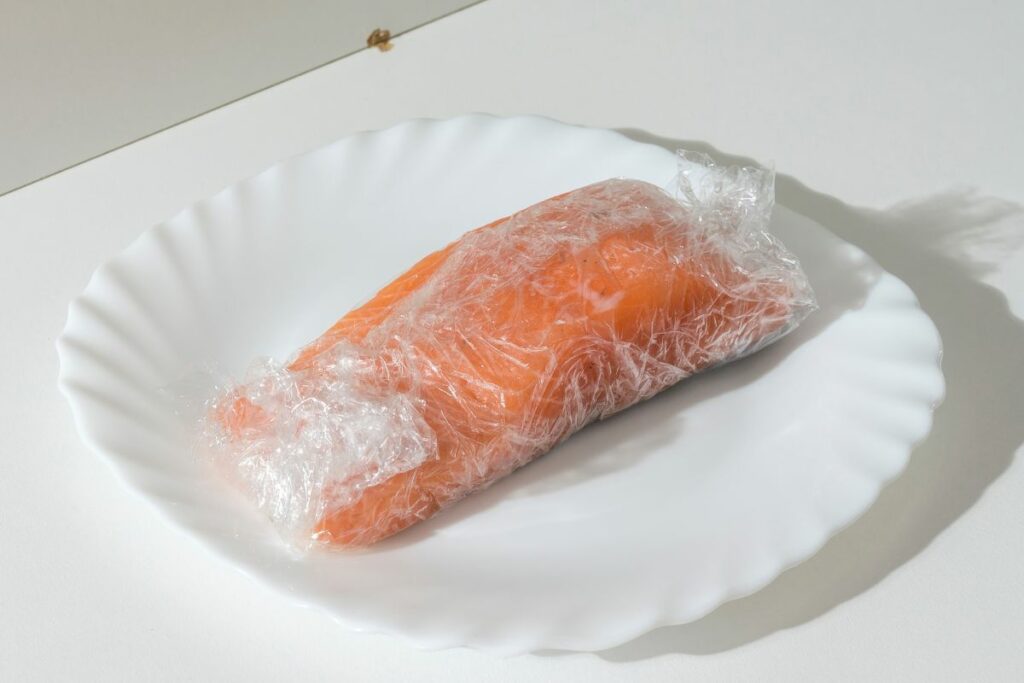Salmon is delicious. When done right it’s silky smooth, and you can enjoy it flaky or moist with a fresh or herby butter, or soaked in wine, or with a flavorful crust.
It’s also wonderfully good for you. It’s rich in protein, and is particularly popular for its omega-3 content, which is important for brain and eye health.

It also has the minerals phosphorus, zinc, and potassium, as well as several B vitamins.
So, if you love salmon, keeping some salmon filets in the freezer is a no-brainer. But what if you want to cook salmon if you’ve forgotten to defrost it in the refrigerator overnight?
Don’t worry, we’ve got you covered…
Can You Defrost Salmon In The Microwave?
The Quick Answer: Yes, you certainly can defrost salmon in the microwave, and in fact, in many ways it’s the superior method. Later on, we’ll be sharing exactly how best to do it. (Please feel free to scroll ahead to see it.)
Coming Up
In this article, we’re going to cover how you need to prepare salmon for cooking, and quickly go through some of the other methods of defrosting salmon for cooking for due diligence before going into how best to defrost salmon in the microwave.
And of course, we’ll clarify for you that it is perfectly safe to defrost salmon in the microwave.
We’ll also give you several tips on defrosting salmon in the microwave, before answering all your most frequently asked questions on the subject.
(Please feel free to scroll ahead to any section that jumps out at you.)
And without further ado, let’s get straight to it!
How To Prepare Salmon Filets For Cooking
Let’s kick things off by answering the main question you may have…
Do You Need To Defrost Salmon Before Cooking?
While many meats can be cooked straight from the freezer, such as lean mince and pork steaks, to be perfectly honest with you, this doesn’t work so well for salmon filets…
According to the USDA (U.S. Department of Agriculture), the thickest part of the salmon should have a minimum internal temperature of 145 degrees Fahrenheit before serving.
But of course, if you were to attempt to cook the salmon straight from the freezer, you risk not getting cooked enough, and being served at too low a temperature, which could result in food poisoning.
As a general rule, it’s often best to defrost or thaw frozen food before cooking it, including salmon.
That way you can be sure that your meat will turn out exactly as intended, and at the same time, reduce the chance of serving uncooked or only partially cooked meats at the dinner table.
The last thing you want to serve up is food poisoning.
Alternative Ways To Defrost Salmon Ready For Cooking – And How Long They Take

Before we go into how best to defrost salmon in the microwave, let me walk you through some of the other methods of defrosting it, so that later you can see microwaving is one of the best ways to defrost salmon, particularly when it comes to just how quick it is to do.
Let’s get straight to it…
Defrosting Salmon At Room Temperature
If you were going to defrost your salmon at room temperature, you would have to keep it in its original packaging and place it on a place to catch the moisture.
But although it can be done this way, it is most certainly not recommended…
It’s not considered safe to defrost fish, including the likes of salmon filets, at room temperature for an extended period of time.
This is because, not only does this method result in a worse flavor and texture, but it also risks excessive bacteria growth, which can lead to food poisoning.
What’s more, the thicker the filets are, the longer the salmon would have to be left out in order for it to thoroughly thaw.
And the USDA states that any meat or fish that is left out at room temperature for more than two hours should be thrown away.
Defrosting Salmon In The Refrigerator
Defrosting salmon in the refrigerator is a much more popular method of defrosting salmon filets, because it’s so much safer than defrosting at room temperature, due to it being that much more difficult for bacteria to grow in such cold conditions.
To defrost your salmon in the refrigerator, it is recommended that you keep it in its original packaging and place it on a plate in order to prevent the meat from getting waterlogged.
Your salmon filets should be left in the refrigerator to defrost for an absolute bare minimum of 12 hours. However, if your salmon filets are very thick, then you may have to leave it to defrost for up to twice as long.
So in most instances, if you want to defrost your salmon in the refrigerator for an evening meal, the most convenient time to do so would be the night before.
Defrosting Salmon In Water
And there’s a third option. Before the invention of the microwave, this was one of the more popular methods for defrosting meats…
There are two methods of defrosting meat and fish in water. One would be to place the fish into a colander and run under cold water until defrosted.
And the other would be to submerge the meat in water. This could take up to half an hour, depending on the thickness of the filet.
What’s The Quickest Way To Defrost Salmon?
So, as you can see, prior to the invention of the microwave, defrosting salmon was quite the time-consuming chore.
If you didn’t have the time to wait while it defrosted in the refrigerator for at least 12 hours, then you would have had to defrost in water for half an hour, or risk food poisoning by defrosting it at room temperature on the kitchen countertop or windowsill.
However, if you were to defrost salmon in the microwave, it can take as little as two to three minutes! Perfect.
Is It Safe To Defrost Salmon In The Microwave?
Now it’s time to address any concerns you may have about defrosting salmon in the microwave…
It’s perfectly safe to defrost your salmon in the microwave, provided that you adhere to food safety standards.
If you want to defrost salmon in the microwave, you will need to observe best practices if you are to avoid any foreseeable issues.
So, we’ll run through some of the main dos and don’ts for you in relation to meeting food safety standards when defrosting meat or fish…
- DO NOT – let your salmon sit at room temperature for an extended period once defrosted. This is because it can cause bacteria to grow on the meat, and this can make it unsafe for consumption.
- DO – defrost the salmon for the correct amount of time. This is essential. You need to heat it for long enough, but you must ensure that you do not overcook the salmon or burn parts of the salmon filet. What’s more, if left to defrost for too long, this can risk ruining the texture of the salmon when it’s served.
- DO NOT – attempt to cook the salmon filets in the microwave, rather than merely defrost them. Even if you nuke it at full power, the microwave works by heating the food from the outside in, which means that the center of the filets will not get properly cooked until the outside edges are burned, which ruins it, affecting both the taste and the texture, and is something that you don’t want.
- DO NOT – assume that you don’t need to flip the salmon over while defrosting it if the filets are very thin. This is not the case.
How To Defrost Salmon In Microwave
The good news is that defrosting salmon in the microwave is really easy…
- Step One – You begin by removing the filets from their packaging and place it on a microwavable plate, such as a traditional ceramic plate, and place it in the microwave.
- Step Two – Set the power level. If your microwave has a “defrost” mode, then use this. Otherwise, turn the power to 30%.
- Step Three – Set the timer. You should set the timer for 3 minutes. If the filets are relatively small in size, then you may be able to get away with defrosting for just 2 minutes. But if you’re at all unsure, it’s best to defrost for a full 3 minutes.
- Step Four – Flip the salmon over several times while defrosting. As the microwavable plate rotates in the microwave, the heat is projected out in such a way that the outer edge of dishes tends to get heated fairly evenly, while the center gets very little heat at all.
Because of this, it’s important that you flip your salmon filets over frequently, such as every 30 seconds while the salmon defrost, in order to facilitate more even defrosting.
This will prevent any unwanted hot spots or overcooking, and ensure that the underside is just as warm as the top.
Tips For Defrosting Salmon In Microwave

Here are some of our top tips for you:
- Cover your salmon filets with a vented lid in order to retain the moisture and succulence of them
- If you’re lucky enough to own a microwave with automatic defrosting functionality, then be sure to take advantage of it, and simply select the defrosting option for fish
- Be sure to flip the filets over periodically every 30 seconds or so in order to prevent hot spots and ensure more even heating
- Give the salmon a chance to stand for a minute or two prior to cooking, since this will help to prevent your salmon filets getting overcooked by ensuring that it gets cooked as evenly as possible
- In order for the fishy smell to dissipate and fade on defrosting, make sure to keep your microwave door open for at least 15 minutes
- If you find that the fishy smell does not fade away as well as you would like, then use a mixture of lemon juice or vinegar in water and some baking soda in order to give the inside of the microwave a good clean
- As a general rule, refreezing salmon that’s been defrosted in the microwave is not recommended, but it can be done if necessary under certain conditions. (More on this in our FAQ section shortly.)
Wrap Up
So to summarize, it certainly is possible to defrost salmon in the microwave.
All you have to do is place it on a microwavable plate, choose the correct setting on your microwave, and microwave for 3 minutes, stopping to turn the salmon over every 30 seconds.
And to expand on that, this method is 10 times quicker than defrosting in cold water, and even quicker than defrosting it in the refrigerator, which takes at least 12 hours.
But please bear in mind that once defrosted in the microwave, the salmon should not be refrozen, unless it has been cooked first.
And that’s a wrap, everybody. I trust that you’ve found this article helpful, and that you now know everything you need to about defrosting salmon in the microwave when you’re in a hurry.
Bon appétit!
Frequently Asked Questions
Yes, it is possible to refreeze defrosted salmon, provided that food safety standards are strictly adhered to. It’s not generally recommended, however, since defrosting salmon changes its texture.
When defrosting salmon in the microwave, there is a slight risk of actually cooking the salmon on the outer edges, and if this happens, this will affect the texture and taste.
For this reason, we recommend that you cook your salmon almost immediately after defrosting it. (Leaving it to stand for a minute or two after defrosting in the microwave is recommended.)
The change of texture and taste in salmon after defrosting also applies when the salmon is defrosted by other means than through the use of a microwave, including at room temperature on a kitchen countertop, or in cold water, since this could also spoil the salmon for refreezing.
The best way to refreeze defrosted salmon, in order to avoid disrupting its texture and taste, is if it had been defrosted overnight in the refrigerator. This method does not disrupt the taste and texture because it doesn’t get warm enough for any significant bacterial growth.
If the salmon is properly cooked once defrosted, however, then it is perfectly safe to refreeze again. This way, the ideal taste and texture should be achieved, and when you’re ready to serve it, all you have to do is reheat it to your preferred temperature, and you don’t have to recook it as such.
- How To Reheat A Cheesesteak - November 5, 2023
- What Are Three Must Have Kitchen Knives? - September 22, 2023
- How To Protect Edges Of Pie Crust - June 15, 2023








